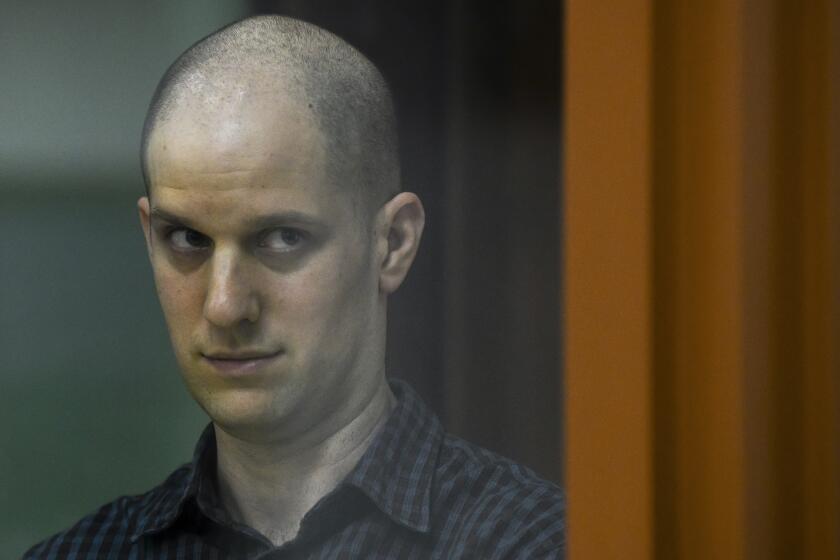Stanford Sets Heady Pace in College Fund Raising
The research that goes on in Stanford University Vice President Henry E. Riggs’ office won’t solve scientific riddles or shed new light on Shakespeare.
His staff doesn’t peer through microscopes or manuscripts. They pore through “Who’s Who,” proxy statements, corporate directories, club lists and other indices of wealth in America.
Riggs, who calls himself Stanford’s “sales manager,” runs a fund-raising operation that last year brought in $125 million for his alma mater. His development office boasts a budget of $9 million and a staff of 190, including one fellow whose sole job is to court donors of $5 million and up.
Biggest Sales Drive Ever
The bow-tied Riggs, a professor of industrial engineering and a former Silicon Valley entrepreneur, is preparing to launch the biggest sales drive ever for an American university: a centennial campaign to raise $1 billion.
The drive won’t officially start until late this year or early in 1987. But Stanford is setting the pace in what has become an explosion of fund-raising drives at campuses across America.
A quarter-century ago, Stanford launched the first $100-million university fund-raising drive, spurred by a $25-million challenge grant from the Ford Foundation. In the 1970s it raised the ante again with the first $300-million drive. Both met their mark.
Today, 40 universities and medical centers are embarked on $100-million-plus campaigns, with combined goals of nearly $7 billion, according to the fund-raising firm of Brakeley, John Price Jones Inc. Eighty other universities also are out trolling for gifts totaling $10 million to $90 million.
The nation’s 3,200 colleges and universities raised $5.6 billion in gifts in 1983-84 alone.
“Most everybody, if they’re not in a capital campaign, they’re at the edge of one,” says Alvin P. Brannick, vice president for development at Carnegie-Mellon University, which just launched a $200-million drive. “When one stops, another starts.”
What will Stanford do with $1 billion?
Create 100 new endowed professorships at $1.5 million apiece. Rebuild, at a cost of $250 million, what Stanford President Donald Kennedy has called its “shantytown” of temporary science and engineering buildings that sprang up after World War II. Construct new dorms to eliminate a housing squeeze, and perhaps even get rid of the campus trailer park. Fund scholarships and independent study for undergraduates. Open new sports facilities. Graduate fellowships. Research centers. The list goes on.
Geology professor Tjeerd H. van Andel says, “You not only have to have valid academic goals . . . they also have to be sexy enough that you can get money for them.”
The centennial goals--in the half-billion-dollar range--will be on top of the $500 million-plus that Stanford expects to raise in the next four years from its regular fund-raising activities.
About a third of the money will wind up in the university’s already robust endowment ($1.4 billion last fall), generating income to cover the costs of education and research that even tuition of $11,208 a year pays only a portion of.
‘A Large Business’
Stanford Provost James N. Rosse says raising $1 billion over four years “will label us as something we are: a large business. . .that needs a large amount of money to work.”
Every other university has a similar tale to tell of great needs and limited resources.
Their appeals have not fallen on deaf ears. America’s blue-chip universities have surpassed even the loftiest goals of late.
Currently, Columbia University is shooting for $500 million, revised upward from its original goal in 1982 of $400 million. Columbia has $390 million in cash and pledges in its coffers with more than a year to go. It launched that drive with a Broadway-style show on a night when an alumnus bathed the Empire State Building in the Lions’ blue-and-white colors.
Johns Hopkins University spent $230,000 on the extravaganza that kicked off its $450-million campaign in 1984, a tent party that featured Steve Allen as emcee, a brass band, an 80-voice student chorus, 45 slide projectors, four video projectors, 38 microphones, two laser beam projectors and a dry-ice machine emitting “smoke.”
Hopkins has already raised $250 million. “A lot of people thought we were being arrogant,” says Morris W. Offit, a New York investment counselor who chairs the campaign. “Now we have to start thinking about possibly raising our sights.”
$400,000 Kick-Off
Carnegie-Mellon kicked off its campaign with a $400,000 show at the Pittsburgh Civic Arena hosted by singer Andy Williams and featuring Jerry Lewis and other entertainers. Some Carnegie-trained stars, including Charles Haid and Barbara Bossom of television’s “Hill Street Blues” and Robert Foxworth of “Falcon Crest,” backed out to protest their alma mater’s acceptance of defense contracts.
The nation’s oldest and wealthiest university, Harvard, completed a five-year drive for its college and public policy schools in 1984 with $359 million. Its original goal was $250 million.
But counting gifts to Harvard’s law, business and medical schools, its total take during 1979-84 was $599.6 million. Last year alone, Harvard raised $145 million.
The resurgence of the U.S. economy after the 1981-82 recession and the current boom in the financial markets has made the fund-raisers’ task easier.
Princeton University is closing a drive that started at $275 million in 1981 and was ratcheted up to $330 million in 1984. It eclipsed that mark in February and surged past $350 million. And Princeton, unlike Stanford, Harvard and most other universities going after the biggest sums, has no medical, business or law schools.
Hospitals associated with universities, like those at Stanford, Hopkins and the University of Miami, are a ready source of what fund-raisers call “grateful patient” gifts.
Well-Heeled Patients
At Hopkins, a development director makes the hospital rounds and arranges for delivery of the Wall Street Journal to well-heeled patients’ bedsides.
The Stanford University Medical Center dispatches famous heart surgeon Norman E. Shumway to make pitches for a $145-million drive that is separate from the centennial campaign.
Public universities have long since joined their private counterparts in the chase. Gifts to the nine-campus University of California system reached nearly $250 million last year. And Ohio State University has raised $112 million in a $350-million campaign announced last fall.
The ability to raise big bucks is not confined solely to the Ivy League and research universities.
DePauw University, a co-ed school in Greencastle, Ind., with 2,300 undergraduates and 24,000 fiercely loyal alumni, has raised $106 million in three years and nearly doubled its endowment.
“People like to give to a university. We’ve not twisted anybody’s arm,” says Executive Vice President Robert Bottoms, soon to become DePauw’s president. One family of alumni gave $10 million anonymously after class reunions--one of the rituals campuses engage in to cultivate loyalty.
Largest Gift Ever
Emory University in Atlanta in 1979 received the largest gift ever from a living donor: $105 million from Coca-Cola magnate Robert Woodruff. It became the springboard for a $160-million campaign that topped out at $220 million.
Dr. Arnold Beckman, founder of Beckman Instruments, gave more than $75 million to research institutions in 1985, including $40 million to the University of Illinois and $12 million for Stanford’s new Center for Molecular and Genetic Medicine.
Last spring, Auburn University was closing the books on a drive that had just topped $100 million when an Auburn dropout pledged $10 million.
George A. Brakeley III, executive vice president of Brakeley, John Price Jones in Stamford, Conn., says, “I don’t know of a single campaign that succeeded without some serendipity--timely death, sleepers that appear.” They counter “the inevitable disappointments.”
Stanford was built on one of the great bursts of philanthropy in U.S. history: railroad magnate Leland Stanford’s 1885 gift of his 8,247-acre ranch here and other lands worth $5 million. The Stanfords subsequently gave $16 million to the university named in honor of their only child, who died of typhoid fever at age 15 while on a trip to Europe.
Riggs’ staff has been planning the centennial campaign for three years and raising tens of millions of dollars for a “nucleus fund” that will be in hand before the curtain is officially drawn.
Hewlett-Packard Pledge
Already Stanford alumnus Bill Hewlett--founder of Hewlett-Packard Co. with classmate David Packard--has pledged $50 million to get the drive rolling.
“Stanford has been important to me and my family, to my company, to this community and to the nation,” Hewlett says. “I wanted to see it strengthened for the future so that it will continue to benefit society through educating promising young people and performing research essential to the progress of mankind.”
Just last week, Packard and his wife, Lucile, pledged $70 million to finance construction of a new children’s medical center at the university. The pledge, the largest commitment from a private donor in Stanford history, included a previous Packard pledge of $20 million.
Physics professor Calvin F. Quate worries that the billion-dollar goal sounds “a bit presumptuous.”
Potential Danger
Riggs calls it “a terribly large number” and says the danger is that a potential major donor might decide that Stanford can get by without his or her $100,000.
Stanford’s development machine was not always so finely oiled.
Robert E. Freelen, Stanford’s vice president for public affairs, says fund raising in the 1961 campaign was “pretty rudimentary.”
“We literally would go to a small valley town in California with an alumni list and look up phone numbers in books and call until we could get a small group of people to meet with us,” he said.
More to Read
Start your day right
Sign up for Essential California for news, features and recommendations from the L.A. Times and beyond in your inbox six days a week.
You may occasionally receive promotional content from the Los Angeles Times.






